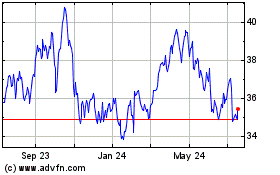Global Oil Demand Closing In on Supply, Executives Say
September 07 2016 - 10:31AM
Dow Jones News
By Sarah McFarlane and Jenny W. Hsu
SINGAPORE -- After repeated false starts, energy executives say
global oil demand is finally catching up with supply, a turning
point in the market after more than two years of a glut weighing on
prices.
"We believe that in June, July actually we might have started to
draw," Andy Milnes, chief executive for Supply and Integration at
BP PLC, referring to global stock drawdowns.
Global oil prices have been under pressure as supply growth has
outpaced demand since 2014, leading to high cost producers curbing
output and investment plans being slashed.
Oil producers and market watchers have made sunny projections in
the past only to see prices fall again when consumption has failed
to live up to expectations and idled production has been brought
back online. But this time, they say, is different.
"The world is demanding more hydrocarbons than it is
producing...There is light at the end of the tunnel," Mr. Milnes
said, speaking at the S&P Global Platts conference in
Singapore.
According to the International Energy Agency, global oil
production exceeded demand by around 250,000 barrels a day in the
second quarter, down from surplus supplies of 1.32 million barrels
a day the previous quarter.
While the IEA has published its June and July supply figures,
there isn't data available yet on demand for all of the period.
Last month it predicted that supply would lag behind demand by
nearly a million barrels a day from July through September.
Industry leaders were optimistic on demand growth in Asia in
particular, where gasoline and crude consumption have been climbing
sharply.
In China, where there are around 100 cars per 1,000 people, car
ownership has potential to triple in the next couple of years, said
Zhang Liucheng, vice president for trading and marketing at
Shandong Dongming Petrochemical, China's largest independent
refinery.
China's crude oil imports in the first half of this year grew
14% to 7.5 million barrels per day, according to government
data.
At the same time, major oil companies have reacted to lower oil
prices by drastically cutting spending on exploration and new
projects with consultancy Wood Mackenzie estimating that the number
of oil discoveries made in 2015 was 2.7 billion barrels, the lowest
volume since 1947, indicating a supply crunch could eventually
materialize.
Global crude prices fell to a 12-year low in February at $26 a
barrel but have since rebounded, with the benchmark Brent contract
up 0.7% at $47.57 a barrel on Wednesday, although still less than
half what it was mid-2014.
The overhang of global stocks could delay a more drastic
rebound, however.
According to Keisuke Sadamori, director of energy markets and
security at the International Energy Agency, world stocks remain
near a record of more than 3 billion barrels.
In some parts of the world where it is difficult to obtain
accurate data on stocks, analysts expect struggling producers may
be monetizing their oil due to the prolonged price decline.
"Just intuitively, if you're in Nigeria or Brazil right now what
do you need, inventories in tank or cash? The answer is cash so
it's certainly plausible they would be running down inventories
there," Seth Kleinman, global head of energy strategy at Citi
said.
"Clearly there is some process of rebalancing going on."
Write to Sarah McFarlane at sarah.mcfarlane@wsj.com and Jenny W.
Hsu at jenny.hsu@wsj.com
(END) Dow Jones Newswires
September 07, 2016 10:16 ET (14:16 GMT)
Copyright (c) 2016 Dow Jones & Company, Inc.
BP (NYSE:BP)
Historical Stock Chart
From Mar 2024 to Apr 2024

BP (NYSE:BP)
Historical Stock Chart
From Apr 2023 to Apr 2024
